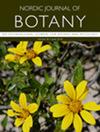小气候几乎无法解释北极苔原地貌全年分解的差异
IF 1.1
4区 生物学
Q3 PLANT SCIENCES
引用次数: 0
摘要
枯落物分解是大气碳流入北极土壤的主要途径,从而控制地下碳的积累。然而,人们对苔原垃圾分解如何随微环境条件变化知之甚少,这阻碍了对未来气候变化下苔原土壤碳动态的准确预测。在 14 个月的时间里,我们在格陵兰西部的 90 个地块中测量了两种对比鲜明的标准枯落物(绿茶和路易波士茶)的景观尺度分解情况,这些地块涵盖了小气候和地形、植被覆盖和特征以及土壤特性的梯度。我们使用茶袋指数(TBI)方案来估算不同空间内枯落物质量损失、分解率(k)和稳定因子(S)的相对变化,并使用结构方程模型(SEM)来确定环境因素与分解之间的关系。与我们的预期不同的是,微观环境因素对观察到的废弃物质量损失、k 和 S 的变化几乎没有解释作用,这表明我们的研究中所包含的变量并不是所研究的苔原地貌中土壤中分解者活动的主要控制因素。我们利用这些意想不到的研究结果,结合现有文献的研究结果,来讨论未来的途径,以提高我们对苔原分解驱动因素的认识,并最终提高我们对整个变暖的北极地区碳循环的认识。本文章由计算机程序翻译,如有差异,请以英文原文为准。
Microclimate explains little variation in year-round decomposition across an Arctic tundra landscape
Litter decomposition represents a major path for atmospheric carbon influx into Arctic soils, thereby controlling below-ground carbon accumulation. Yet, little is known about how tundra litter decomposition varies with microenvironmental conditions, hindering accurate projections of tundra soil carbon dynamics with future climate change. Over 14 months, we measured landscape-scale decomposition of two contrasting standard litter types (Green tea and Rooibos tea) in 90 plots covering gradients of micro-climate and -topography, vegetation cover and traits, and soil characteristics in Western Greenland. We used the tea bag index (TBI) protocol to estimate relative variation in litter mass loss, decomposition rate (k) and stabilisation factor (S) across space, and structural equation modelling (SEM) to identify relationships among environmental factors and decomposition. Contrasting our expectations, microenvironmental factors explained little of the observed variation in both litter mass loss, as well as k and S, suggesting that the variables included in our study were not the major controls of decomposer activity in the soil across the studied tundra landscape. We use these unexpected findings of our study combined with findings from the current literature to discuss future avenues for improving our understanding of the drivers of tundra decomposition and, ultimately, carbon cycling across the warming Arctic.
求助全文
通过发布文献求助,成功后即可免费获取论文全文。
去求助
来源期刊

Nordic Journal of Botany
生物-植物科学
CiteScore
1.90
自引率
11.10%
发文量
100
审稿时长
2 months
期刊介绍:
Nordic Journal of Botany publishes original contributions on all aspects of the taxonomy, evolution, conservation, ecology and biogeography of plants (including algae and bryophytes) and fungi.
 求助内容:
求助内容: 应助结果提醒方式:
应助结果提醒方式:


